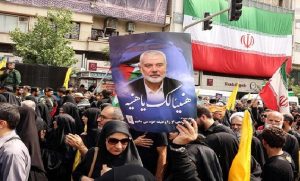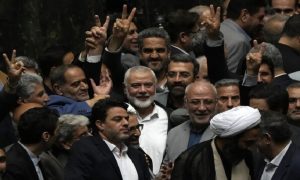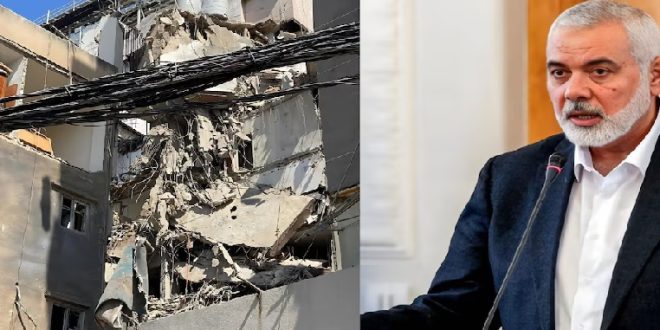04-08-2024
TEHRAN: The IRGC-affiliated media has vehemently rejected a report by the New York Times regarding the assassination of Hamas leader Ismail Haniyeh, which claimed he was killed by an explosive device hidden in his room two months before the hit.
 “These lies are being propagated while the results of the experts’ investigation indicate that Haniyeh was struck by a projectile, in which involvement of the Zionist regime cannot be ruled out,” read a report by Fars news agency.
“These lies are being propagated while the results of the experts’ investigation indicate that Haniyeh was struck by a projectile, in which involvement of the Zionist regime cannot be ruled out,” read a report by Fars news agency.
Citing five Middle Eastern officials, the New York Times report claimed the bomb was hidden in the Islamic Revolutionary Guards Corps-run guesthouse in the Neshat compound in northern Tehran, the report states.
The newspaper detailed that the explosion, which occurred around 2am local time, was triggered remotely and caused significant damage. It shook the building, shattered windows, and partially collapsed an exterior wall.
It is not clear who the Middle Eastern officials are, and if they are from countries friendly with Iran, that would have an interest in offering a scenario less damaging to the IRGC or the Iranian regime. Some Iranian journalists and activists shed doubt on the veracity of the report, saying that the Iranian regime does not want to appear totally unable to defend itself against foreign missile or drone attacks. However, the Fars News insistence that a projectile hit the building appears to weaken this argument.
The assassination of Haniyeh, who was in Tehran for the inauguration of President Masoud Pezeshkian, has sparked speculation about the method of his killing.
Earlier, most observers had said that the killing was done by a projectile hitting the specific part of the building where Haniyeh was spending the night.
However, the NYT article says the meticulous planning behind the attack was such that, despite the proximity of Ziyad al-Nakhalah, leader of the Palestinian Islamic Jihad, who was staying next door, his room sustained minimal damage, as claimed by two Iranian officials.
Reports, including those from Iranian state media, suggest he may have been targeted by a drone or a precision-guided missile, with Special Forces in Tehran directing the strike from nearby windows.
 Another theory posited by Iranian media suggests that spyware was installed on his phone, enabling his location to be monitored and ultimately leading to his tracking and assassination.
Another theory posited by Iranian media suggests that spyware was installed on his phone, enabling his location to be monitored and ultimately leading to his tracking and assassination.
To date, Iranian officials have not commented on the specific circumstances surrounding the death of the figure who had been the key bridge between Iran and Hamas since 2017.
The report lacks several key explanations, including why Haniyeh, who had stayed at the guesthouse multiple times during his visits to Tehran, was targeted on this occasion without clarifying the specific reasons for the timing of the attack.
The NYT’s report contradicts statements by Pezeshkian’s supporters who have insisted that the attack was aimed at his new administration. If the bomb was placed two months ago, at that time Pezeshkian was not even a presidential candidate.
‘Reformist’ journalist and political activist Ahmad Zeidabadi stated on Thursday that the “primary objective” of the attack on Haniyeh was to “destabilize and potentially paralyze the Pezeshkian government from the outset.”
Regardless of the method employed, it is evident that even Iranian officials acknowledge a significant failure on Iran’s part to protect Haniyeh, reflecting a profound lapse in adequate security. (Int’l Monitoring Desk)
 Pressmediaofindia
Pressmediaofindia




